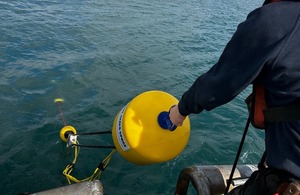Floating signs to protect Looe seals from watercraft
The Looe Island Marine Wildlife Code Project sees deployment of new signage in this key habitat for Atlantic grey seals.

Looe buoys project. Photo: Seawide Services Ltd
An innovative project that will promote responsible enjoyment of Cornwall’s incredible marine life in and around Looe Island is launching today.
The Looe Island Marine Wildlife Code Project will see two marker buoys displaying signage to encourage people to follow Defra’s Marine and Coastal Wildlife Code in order to minimise disturbance of seals that inhabit Looe Island.
The island is a key habitat for Atlantic grey seals, especially at low tide when they rest on exposed rocks.
Unfortunately, the island’s accessibility to various watercraft—including kayaks, motorboats, jet skis, and paddleboards—has led to increased pressures on local wildlife, in particular, seals. Surveys since 2008 have documented a significant rise in disturbances, posing a threat to the seal and bird populations.
As new buoy anchors were due to be mounted, partners Natural England, the Looe Marine Conservation Group (LMCG), the Looe hub of the Cornwall Seal Group Research Trust and the Looe Harbour Authority worked together on a project to maximise their ecological benefit and minimise their carbon footprint.
Using an Advanced Mooring System (AMS) and Reef-Cube® anchorage, the marker buoys’ moorings are designed to prevent damage to the seabed.
The low carbon, recycled concrete Reef-Cube® anchors, developed by ARC-Marine of Ruan High Lanes near Truro, are designed to allow rapid colonisation by marine life, providing shelter and mimicking natural rock habitats.
Selecting a low-impact mooring system was especially important because the signage will be within a Marine Conservation Zone. For this, the Seaflex Mermaid-K AMS system was chosen. This is a product from a collaboration involving Seaflex and Blue Parameters.
The Mermaid-K system is designed as an “Advanced Sustainable Mooring System” with a focus on minimising environmental impact through the elimination of traditional chain components, which can cause seabed scouring and damage to sensitive habitats.
In addition, the elastic properties of the system allow for absorption of wave energy, and thus less stress on the sea floor and the marker buoys prolonging the life of the buoys.
Liz Bailey, project lead, of Natural England said:
Seals are naturally curious animals who are interested in what is going on around them and we all love to see them in their natural environment.
Unfortunately, leisure users can cause harm to seals, often without realising. Even a seal looking straight at a human can indicate a level of disturbance - an increased alertness and a readiness to stampede into the water.
If seals become stressed and enter the sea in a hurry they can suffer injuries and become weak from lack of adequate rest and digestion time. In severe cases disturbance can cause mortality to seal pups, either while the mothers are pregnant or by causing mothers to abandon pups.
Fortunately, there is some great guidance in place, which can help sea-users enjoy observing our wonderful seals, while ensuring seals can thrive in the waters we share with them.
Cliff Davies, of LMCG said:
The deployment of these marker buoys is a significant milestone in our conservation efforts.
By providing clear guidance to water users and employing eco-friendly technologies, we are taking proactive steps to safeguard the precious marine life around Looe Island.
This initiative not only protects the grey seals and birds but also enhances the overall health of our marine environment for future generations.
Sue Sayer MBE, Director of the Cornwall Seal Research Trust and Chair of Seal Alliance Executive, said:
Coastal species need our respect and help. Awareness raising in situ (prior to the point of impact) is vital, as most of us never want to impact the iconic species we love seeing around our shore.
This innovative project is being keenly followed by organisations globally, as a replicable, proactive community solution to the increasing issue of marine disturbance, at a time when our wildlife needs it the most.